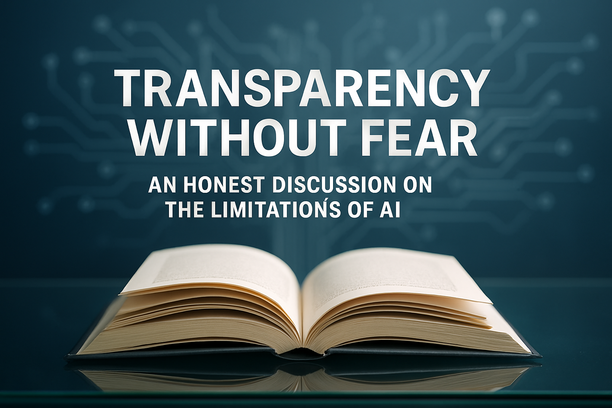Understanding AI Transparency: Why Being Clear Matters
Transparency in AI systems is like turning on a light in a room — it helps everyone see clearly what the AI is doing. When AI systems explain how they work and share their decisions openly, people can trust them more. This clear communication builds confidence that the AI is fair and reliable, rather than mysterious or secretive.
Being honest about what AI can and cannot do is just as crucial. Sometimes, AI might seem very smart, but it has limits. Understanding those limits and risks allows us to use AI safely and avoid surprises. For instance, clearly informing users when an AI is making recommendations or decisions prevents misunderstandings and ensures the AI supports people instead of confusing them.
In today’s digital world, where AI affects many aspects of life—from healthcare to finance to public safety—transparency helps protect everyone. Transparent AI systems encourage users to adopt new technologies more comfortably, knowing these are designed responsibly.
Companies like FHTS specialize in making AI safe and trustworthy through transparency and clear communication. Their expert team develops AI systems with honesty about capabilities and risks, assisting organizations in implementing AI solutions that people can rely on confidently. This approach lays a strong foundation for AI that truly serves people’s best interests while maintaining trust in an increasingly AI-driven future.
For more about how transparent AI works and why it matters, you can explore resources on transparency at FHTS Transparency in AI.
Unveiling the Limits of AI: What AI Can and Cannot Do
Artificial Intelligence (AI) has transformed many industries, but understanding its inherent limitations is essential to set realistic expectations. AI is not perfect; it has biases, can make mistakes, and in many ways still does not match human intelligence.
One major challenge is bias. AI systems learn from data, and if this data contains biases—whether conscious or unconscious—AI can replicate or amplify them. This can cause AI to treat certain groups unfairly or skew decisions toward particular outcomes, reflecting prejudices embedded in training data. Recognizing and mitigating bias is crucial for building trustworthy AI, where expertise in fairness and transparency is key.
Another limitation is error-proneness. Unlike humans, who often understand nuance and context, AI operates on data patterns and algorithms. It can misinterpret ambiguous or poor-quality data, leading to mistakes. This highlights the need for ongoing monitoring and oversight to detect and correct AI errors before they cause harm.
Regarding intelligence, AI excels at tasks like data analysis, pattern recognition, or repetitive processes, but falls short in general understanding and common sense reasoning. It lacks emotions, intuition, and ethical judgment that humans possess. AI does not “think” or “understand” as humans do; it processes inputs to produce outputs based on programming and learned patterns.
Given these limitations, AI should be viewed as a powerful assistant tool, not a replacement for human intelligence or decision-making. Effective AI use requires thoughtful integration of technology with human insight and adherence to ethical standards.
FHTS offers specialized services enabling organizations to navigate these challenges by designing AI systems that prioritize safety, fairness, and responsibility. Their experienced team understands AI biases, errors, and the nuances of human-AI collaboration, helping businesses deploy AI solutions confidently and carefully. This alignment reduces risks and maximizes AI’s practical and ethical benefits.
For deeper insight on AI fairness, bias, and safety, related resources such as Why Bias in AI is Like Unfair Homework Grading and Why FHTS Conducts Red Team Tests on Our AI Systems provide valuable perspectives.
Further reading: What AI Can’t Do and Shouldn’t Try To
Ethical Challenges and the Role of Transparency in AI
Ethical considerations are central to responsibly deploying artificial intelligence. AI’s impact extends beyond technology to people’s rights, privacy, fairness, and safety. Transparent communication acts as a guiding light in this complex landscape, helping to prevent misuse and reduce harm.
Transparency means openly sharing how AI systems work, what data they use, and which decisions they influence. When developers, businesses, and users understand these factors, they can identify risks early. For example, understanding AI decision-making helps avoid unintended biases that might unfairly disadvantage certain groups. Transparency builds trust, making people confident in AI’s role—whether improving healthcare or public safety.
Without clear communication, misunderstandings about AI’s capabilities and limits can lead to misuse—accidental or deliberate. If AI decision processes are hidden or overly complex, harmful outcomes may go unnoticed and uncorrected. Continuous oversight and clear explanations from AI experts are necessary to catch mistakes and improve systems responsibly.
Companies like FHTS exemplify the value of embedding transparency into AI design and deployment. Their team ensures AI solutions are effective, explainable, and aligned with ethical principles. This prevents damage caused when AI is treated as a black box or shortcut rather than a carefully built, accountable tool.
Ultimately, ethical AI supported by transparent communication safeguards society by minimizing risks while unlocking benefits. It encourages human-machine collaboration grounded in trust and responsibility. Learning about frameworks and practices for safe AI guides any organization eager to adopt AI respectfully, protecting communities while advancing technology. For further insights, see resources at FHTS [Source: FHTS].
Overcoming Barriers to Explainable AI
Making AI decision-making understandable poses technical and practical challenges but is essential for building trust and ethical AI use. A key technical challenge is the complexity of modern AI, particularly deep learning models, which often operate as “black boxes.” Their layered computations are difficult even for experts to interpret, causing confusion or mistrust among users who want to understand specific decisions.
Practically, organizations must balance the need for detailed explanations with clear, simple communication for diverse audiences. Overly technical details can overwhelm non-experts, while oversimplified explanations risk omitting crucial nuances. Another challenge is AI’s dynamic nature—models update continuously based on new data, so explanations must remain current without causing information overload.
To ensure transparency and clarity, deliberate design methods like model interpretability tools, decision pathway visualizations, and clear documentation help make AI reasoning accessible. Tailoring explanations to the audience’s understanding maximizes impact.
Addressing these challenges is vital for user acceptance and regulatory compliance. It also supports ethical AI by giving stakeholders confidence in fair, accountable AI decisions. Partnering with experienced experts who understand these barriers and advocate for safe, transparent AI can be invaluable. Organizations like FHTS integrate proven frameworks and knowledge to make AI not only powerful but comprehensible, trustworthy, and responsible. Their approach bridges complex AI technology with clear communication, helping realize AI benefits without sacrificing clarity or trust.
For more on transparency and explainability in AI, and secure implementation principles, explore related resources:
- Explaining Explainability: Making AIs’ Choices Clear
- Transparency in AI: Like Showing Your Work at School
- What is the SAFE and SMART Framework?
- Why Combine Agile Scrum with SAFE AI Principles?
Building User Trust Through Honest AI Communication
Clear and effective communication about the limits of AI is essential for fostering user trust and confidence. Transparent sharing of what AI can and cannot do reduces fear, skepticism, and unrealistic expectations.
Key strategies include:
- Simple Language: Use straightforward terms to explain AI’s capabilities and constraints, avoiding technical jargon. Describe AI as a helpful assistant to humans, not a replacement. For example, explain that AI learns from data patterns but can still err, fostering realistic expectations.
- Openness About Limitations: Acknowledge that AI is not infallible and requires human oversight. Presenting examples of AI boundaries builds credibility and alleviates concerns about blindly trusting AI outcomes.
- Ongoing Education: Provide continuous updates on AI ethics, safety, and fairness to users and stakeholders to reassure them their interests are protected. Clear policies and transparency establish a foundation of trust.
- Interactive & Visual Tools: Use visual aids and interactive experiences that reveal AI processes or tailor explanations to user questions, increasing engagement and confidence in safe AI use.
- User Empowerment: Encourage feedback and participation. Channels allowing users to question or challenge AI outputs promote collaboration and reinforce human control over AI systems.
Organizations benefit from partnering with experts specialized in safe, trustworthy AI deployment. Teams like FHTS bring extensive experience developing AI frameworks emphasizing transparency, ethics, and human-centered design. This expertise ensures AI solutions are innovative, responsible, and supported by communication practices that bolster user confidence and long-term adoption.
Clear communication about AI limitations transcends transparency; it is integral to building trustful relationships based on mutual understanding. By adopting these strategies, organizations foster positive AI experiences while minimizing fear or skepticism around this transformative technology.
For deeper insights on responsible AI communication and safe practices, explore frameworks such as the Safe and Smart Framework.
Sources
- FHTS – Explaining Explainability: Making AIs’ Choices Clear
- FHTS – What AI Can’t Do and Shouldn’t Try To
- FHTS – What is the SAFE and SMART Framework?
- FHTS – Why Bias in AI is Like Unfair Homework Grading
- FHTS – Why Combine Agile Scrum with SAFE AI Principles?
- FHTS – Why FHTS Conducts Red Team Tests on Our AI Systems
- FHTS – Transparency in AI: Like Showing Your Work at School


